by Ed and Kathleen Praxel
What were we doing here in the dirt alongside a cobbled road somewhere in southern Mexico helping change a wheel on a well-used Buick Roadmaster? The young driver of the beat up “road warrior” seemed vague as to where he was and where he was going. The lug nuts on the wheel were rounded so his wrench, with only the one fitting, was worthless. Fortunately, another car stopped and asked if he could be of assistance. He had a four-way wrench and a hammer, so we resized the nuts with force and then fit the shoddy-looking spare without tipping the car off the suicide bumper jack. We took a few minutes to introduce ourselves while I dusted off my clothes. The driver explained that he and several partying friends had made a wager. They challenged each other to buy an old but running vehicle and see how far into Mexico they could get before quitting. The person with the most miles won. Say again?! After bidding the driver, “Good luck!” we then headed for San Cristobal de las Casas, arriving after sunset, and found a pension for lodging. At dinner that night we met a newly married couple honeymooning in Mexico who were having their own adventure by touring the country on rural buses—a peso a mile. These “Pesarios” were like a colorful markets
on wheels.
Over half a century ago, in 1963, my wife and I decided to drive an MG 1100 sports sedan from Spokane, Washington, on the newly opened but not completed Pan American Highway to the Panama Canal Zone. A trip of over 5,000 miles. We thought it would be a fun adventure, and it was. The road surfaces were as varied as the terrain itself. Taking photos along the way was also a challenge as we processed our black & white film each night in the bathroom of the place where we stayed and hung the film to dry in a closet. It reminded us of the old frontier when traveling photographers processed photos in their enclosed wagons.
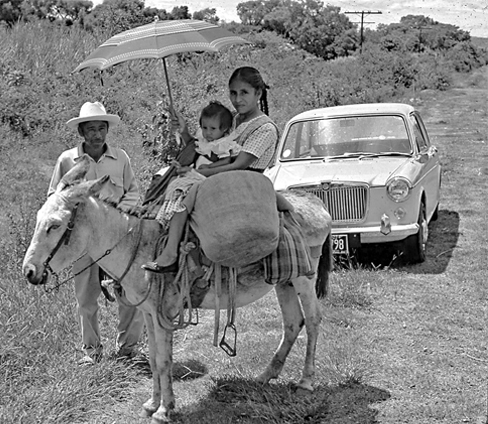
In Oaxaca, Mexico, the early morning stillness was only interrupted by the braying of burros. There was always activity of interest along the InterAmerican Highway and this colorful family was going to a birthday party for their one-year-old daughter. 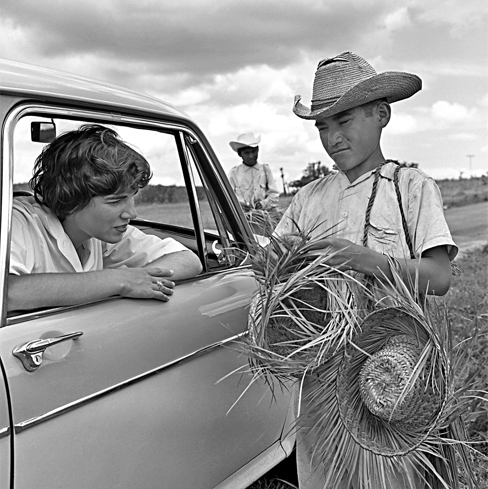
Oaxaca, Mexico was the approach to Monte Alban, a large pre-Columbian archeological excavation, which is now a World Heritage site. The road up the mountain was a steep climb and as we crested the top, the 20th Century was momentarily in contrast to the centuries-old acres of the city.
The first real challenge of the MG’s capable front-wheel drive and hydrolastic suspension was the “El Tapon” in Guatemala—also known as “the stopper.” This was a forty-mile stretch of constantly shifting road surfaces and frequent landslides. Our options were either to attempt the El Tapon or ride on the coastal railway with the car and us riding in it, secured to a flatcar. We risked the unknowns of the El Tapon and encountered five landslides in those 40 miles. There were trucks along this stretch that would help with the rescue of stranded travelers, but we managed to motor through.
With the slides behind us, we pulled off the road at the first available spot to check the undercarriage. The muffler was still intact. We stopped for a lunch break next to a small ravine where a suspension foot bridge crossed to the other side. Unexpectedly, from under the bridge the melodic sound of a marimba drifted upwards.
We arrived in San Salvador, capitol city of El Salvador, late in the evening after a long day on the road. We parked in the main plaza and decided to sleep in the car, rather than look for accommodations. Nearby was a large tiered water fountain surrounded by a party, which made sleep impossible. One of the partygoers climbed into the fountain, oblivious of us and proceeded to take a bath. Amid laughter and giggles we gave up on the idea of sleep and departed the same way we arrived—in the dark. On the way to the Honduran frontier we encountered a memorable sight—a long line of oxen and carts, illuminated by candles hanging from the yokes, wending their way to market.
We drove through Honduras in several hours seeing only a hot, moon-like landscape with large iguanas sunning themselves on rocks.
Nicaragua was defined by Lake Nicaragua where a sinister looking volcano rose from the lake and the waters are inhabited with a species of freshwater sharks!
Silt-like ash from the erupting volcano, Mount Irazu, inundated the capital, San Jose, Costa Rica, and street sweepers were kept busy pushing the residue into gutters. The bathtub in our motel had to be cleaned of fine ash before it could be used. Seventeen years later we would experience a similar ash situation back in Spokane, when Mount St. Helens erupted some 300 miles away. South of San Jose the pavement ended at Cartago and the road began to climb towards the 11,300 ft. pass over Cerro del Muerte or the “Mountain of Death.” In the distance Mount Irazu was visible with its ash plume drifting towards San Jose. There were no guard rails, so vigilance was required so as not to contribute to the mountain’s name.
Balboa, Panama, Canal Zone on the Pacific side, was within a day’s drive of the Panamanian border. We didn’t need to use our ingenuity to overcome any misadventure. And even though the tires were pretty skinny, we didn’t have a flat on the entire journey. It was a welcome sight to see the engineering feat of the Canal and its traversing ships. We drove over the “Bridge of the Americas” and into the Canal Zone with a well-deserved sense of accomplishment. MM
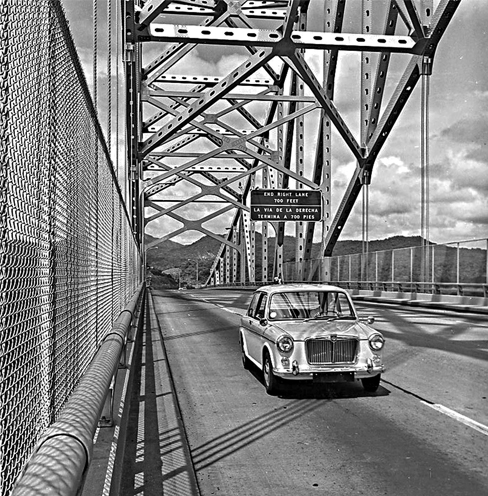
Bridge of the Americas 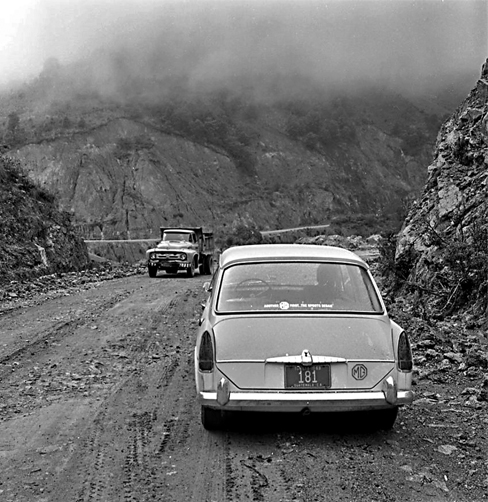
El Tapon and one of the helpful truckers




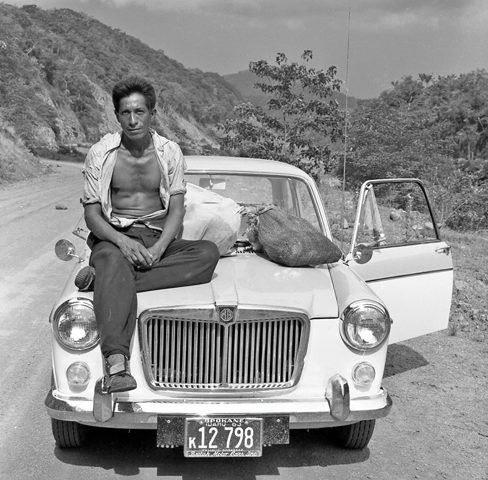
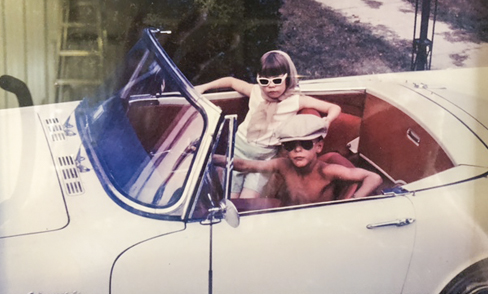
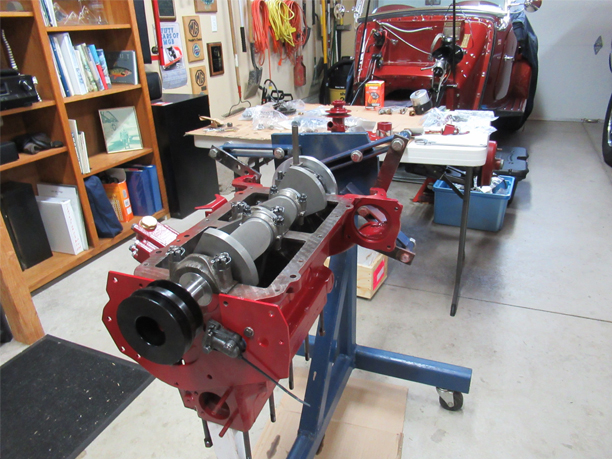
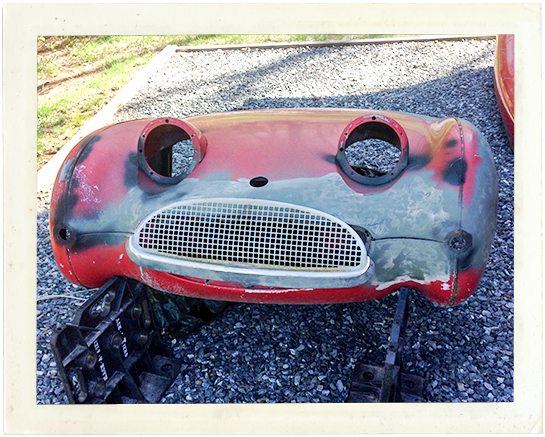
'Images Along the Pan-American Highway' have 8 comments
January 19, 2022 @ 7:35 am Laura Fickes
This was a fascinating article. What a trip! Did the author and his wife drive back to Spokane or did they find another way home once in the Canal Zone?
February 12, 2022 @ 6:23 pm Edward Praxel
Hello, No, I was newly employed by the Panama Canal Company and there wouldn’t have been time to return to Spokane. We eventually did return to Spokane 13 years later via England. We lived in England for 5 years and I raced a Lotus 69 Formula Ford in club events on the various race circuits around Britain. – Ed Praxel
February 1, 2022 @ 9:10 am Robert K. Prevett
I too had an MG 1100 in 1971-72. I was 16yrs and traded my older brother for the car. Don’t remember exactly what we traded, think it was an old non running Chevy pickup. One of the hydraulic suspension parts was low so the car tilted to the right. But she ran great!!! I dove that little red baby all over California before I traded it for an old T-bird. Can not find another one for love or money!! But sure wish I could. Loved that car!!!!
February 1, 2022 @ 9:13 am Cliff watts
This is remarkable. In 1975, after BLMC had had another 12 years to develop and improve the 1100 platform, we arrived in the San Francisco Bay Area. On our daily commutes the sight of Austin Americas littering the shoulder of Interstate 80 was common.
February 1, 2022 @ 12:12 pm Jo Anne Herem
How long have these two been married now? How many children, grandchildren, etc? Are they aware of what bad asses their grandparents were? Awesome story!
February 3, 2022 @ 3:25 am Keith Oliver Foley
Remarkable journey and very brave. Thank you Ed and Kathleen. It brought back memories of my girlfriend and me (now wife of 53 years) journey from southern England to East coast of Italy, Rimini in 1967. We did the camping trip in
A 1962 Austin Healey Sprite Mk2 taking the Channel ferry at Southamton to Cherbourg France then over the Alps to Italy. Total miles return about 3000 with no mechanical incidence. We have colour transparencies of the trip which are viewed often by family members.
February 23, 2025 @ 2:37 pm Brian Hunt
I read Keith Foley’s response to your piece with great interest. I bought Keith’s car BWC 701 from him at 77,777 miles with no clue of its adventurous life. Originally finished in red and equipped with a 1098cc engine, it had been repainted in black and was my first sports car. I fitted a smaller recon engine and sold it on while it was still in one piece.
I lost contact with Keith and Eileen when they moved to Canada and was surprised and pleased to learn of their early adventures via this article.
June 17, 2025 @ 12:11 am Pablo C Olivares
Hi. I’m want to find out if there has been a road in North America with the name Pan American. Highway. As per Wikipedia, in the earliest 1960s, ”the new U.S. Interstate Highway System brought official status to most previously unofficial routes in the lower 48 states.
No road in the U.S. or Canada is officially designated as part of the Pan-American Highway, which officially begins at the U.S.-Mexico border in Nuevo Laredo and runs south.”. Thanks